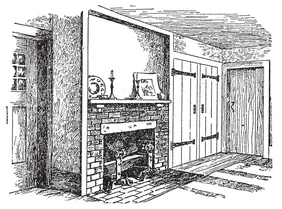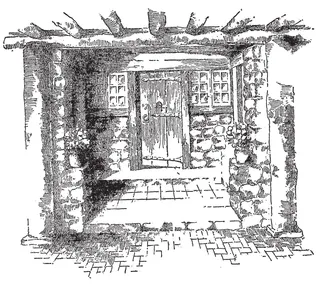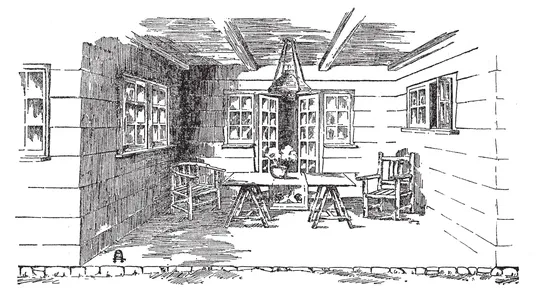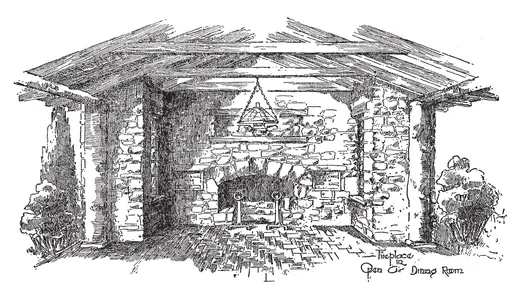
eBook - ePub
Craftsman Houses
The 1913 Catalog
Gustav Stickley
This is a test
Buch teilen
- 144 Seiten
- English
- ePUB (handyfreundlich)
- Über iOS und Android verfügbar
eBook - ePub
Craftsman Houses
The 1913 Catalog
Gustav Stickley
Angaben zum Buch
Buchvorschau
Inhaltsverzeichnis
Quellenangaben
Über dieses Buch
Gustav Stickley pioneered a form of architecture based on beauty, simplicity, utility, and organic harmony. This inexpensive reprint of a very rare catalog testifies to the enduring charm of his designs. It comprises numerous architectural drawings and photographs of Mission-style homes, including floor plans and descriptive text.
`Planned for comfort, convenience, and economy,` each of these homes features a simple arrangement of rooms and sturdy structural features. Combining good taste with practicality, they offer openness for common household life, as well as sufficient seclusion for privacy. Models range from a two-family house of cement or stucco to a nine-room cottage of brick and shingles and a seven-room country bungalow. Restorers of old houses, preservationists, and students of American architectural history will prize this well-illustrated treasury of authentic plans and details.
`Planned for comfort, convenience, and economy,` each of these homes features a simple arrangement of rooms and sturdy structural features. Combining good taste with practicality, they offer openness for common household life, as well as sufficient seclusion for privacy. Models range from a two-family house of cement or stucco to a nine-room cottage of brick and shingles and a seven-room country bungalow. Restorers of old houses, preservationists, and students of American architectural history will prize this well-illustrated treasury of authentic plans and details.
Häufig gestellte Fragen
Wie kann ich mein Abo kündigen?
Gehe einfach zum Kontobereich in den Einstellungen und klicke auf „Abo kündigen“ – ganz einfach. Nachdem du gekündigt hast, bleibt deine Mitgliedschaft für den verbleibenden Abozeitraum, den du bereits bezahlt hast, aktiv. Mehr Informationen hier.
(Wie) Kann ich Bücher herunterladen?
Derzeit stehen all unsere auf Mobilgeräte reagierenden ePub-Bücher zum Download über die App zur Verfügung. Die meisten unserer PDFs stehen ebenfalls zum Download bereit; wir arbeiten daran, auch die übrigen PDFs zum Download anzubieten, bei denen dies aktuell noch nicht möglich ist. Weitere Informationen hier.
Welcher Unterschied besteht bei den Preisen zwischen den Aboplänen?
Mit beiden Aboplänen erhältst du vollen Zugang zur Bibliothek und allen Funktionen von Perlego. Die einzigen Unterschiede bestehen im Preis und dem Abozeitraum: Mit dem Jahresabo sparst du auf 12 Monate gerechnet im Vergleich zum Monatsabo rund 30 %.
Was ist Perlego?
Wir sind ein Online-Abodienst für Lehrbücher, bei dem du für weniger als den Preis eines einzelnen Buches pro Monat Zugang zu einer ganzen Online-Bibliothek erhältst. Mit über 1 Million Büchern zu über 1.000 verschiedenen Themen haben wir bestimmt alles, was du brauchst! Weitere Informationen hier.
Unterstützt Perlego Text-zu-Sprache?
Achte auf das Symbol zum Vorlesen in deinem nächsten Buch, um zu sehen, ob du es dir auch anhören kannst. Bei diesem Tool wird dir Text laut vorgelesen, wobei der Text beim Vorlesen auch grafisch hervorgehoben wird. Du kannst das Vorlesen jederzeit anhalten, beschleunigen und verlangsamen. Weitere Informationen hier.
Ist Craftsman Houses als Online-PDF/ePub verfügbar?
Ja, du hast Zugang zu Craftsman Houses von Gustav Stickley im PDF- und/oder ePub-Format sowie zu anderen beliebten Büchern aus Architecture & Residential Architecture. Aus unserem Katalog stehen dir über 1 Million Bücher zur Verfügung.
Information
Thema
ArchitectureCRAFTSMAN BUILT-IN FITTINGS AND WOODWORK
Not only will the fittings add to the cost of construction, but they will require the work of a skilled carpenter—which is sometimes difficult to get. We do not advocate built-in fittings except where the rooms are essentially suited to them—where there is an alcove or recess, or a wall space which they can entirely fill; in other words, where they will be really “fitments” in the sense in which the word is used in England. In such cases the built-in fixtures become a permanent, integral part of the interior construction, and by filling up the recesses or extending across the end of a room they lessen proportionately the floor space and corners to be cleaned.
The exact design of the built-in features will naturally be governed by individual conditions and the owner’s fancy and purse, but in a typical Craftsman interior it is always best to keep the construction rather plain, relying on the practical lines and proportions of each piece and the natural interest of the materials to bring about a decorative result. The variations of tone and grain in the wood itself, mellowed and emphasized by a Craftsman stain, and the warm glint of light and color in the hammered copper, brass or iron trim—all these things, while part of a practical construction, will help to make the interior more homelike and beautiful.

SUGGESTION FOR CHIMNEYPIECE IN A SIMPLE BEDROOM.
THE WOODWORK
THE question of interior trim and finish is one of great interest to the Craftsman home-builder, for so much of the beauty and interest of a room depends on the woodwork.
First the kind of wood should be considered. For the hall, living room and dining room we find that the most suitable woods are oak or chestnut, cypress, ash or elm, as their comparatively coarse texture and definite grain give them a look of rugged frankness that is extremely attractive and satisfying.
Upstairs, where privacy rather than openness is the characteristic of the plan, and where the hangings and decorations are more delicate in both material and coloring than those below, the woods most in keeping are those having a finer and less pronounced grain and a smoother surface. Maple, beech, birch and red gum are among the kinds most appropriate here.
As to the staining and finishing of the wood—we feel always that the most pleasing effects are obtained when the natural interest of grain and texture is retained, and enhanced by deepening the color and at the same time protecting the surface with a soft, mellow finish—choosing preferably some shade of brown, brownish green or gray.
No matter what kind of wood or what color scheme is selected, if the owner wishes to have a typical Craftsman interior he will naturally wish to finish his woodwork along the lines just suggested, using the Craftsman Lustre described on the inside back cover of this book.
PORCHES, SUN ROOMS AND BALCONIES
PEOPLE are coming to believe more and more in the wholesomeness of outdoor living, and they want their houses planned with sheltered porches, pergolas and balconies so that they may work and play, rest and eat, and in many cases sleep also in the open air. Provision for these needs is one of the chief characteristics of a Craftsman house, as a glance through the plans in this book will show.
Just how such open-air accommodation is to be arranged will depend on such factors as the climate in which the house is to be built, the size and cost of the building, the arrangement of rooms and exterior, and the preferences of the family.
Usually a roomy porch can be provided at the front or side of the house, either sheltered by the projecting roof as in the plans on pages 66, 68 and 74, or recessed as shown on pages 73, 76, 78, 86 and 95. This protects the entrance, provides a pleasant place for outdoor living during the summer, and when the construction and exposure are suitable, the space may be glassed in for the winter to form a sun room. In the bungalow plan on page 90 an interior court is shown which suggests in what a variety of ways a sheltered outdoor space may be provided. Sometimes a separate dining porch may be arranged opening from the dining room and kitchen, and it is always well to have a kitchen porch for the pleasure and convenience of housewife or maid.

SHELTERED ENTRANCE PORCH OF FIELD STONE AND RUSTIC.

SUGGESTION FOR RECESSED OPEN-AIR DINING ROOM IN CRAFTSMAN COUNTRY BUNGALOW NO. 53. (SEE PAGE 6).
“THERE IS NOTHING SENSATIONAL ABOUT THE CRAFTSMAN. IT IS ALWAYS WORTH READING. ”
—Toledo Blade.
Where the porch projects from the house as shown on page 105, and there is danger of darkening the rooms within, it is a good plan to have a solid roof over the entrance only, and a pergola roof over the rest of the porch.
In planning the sleeping balcony the most convenient way, as a rule, is to have it open from one or more of the bedrooms, and to build it so that it is somewhat sheltered by the roof or sides of the house. Additional protection can of course be given by an awning, if desired. Where there is a dormer a sunken balcony may be built, as in the house illustrated on page 85, and in a construction like that shown on pages 88 or 92 a balcony may be provided under the roof above the recessed porch.
THE WINDOWS
AN important feature of the house is the windows, for they may make or mar the beauty of a room or outside wall. One often finds, on analyzing an unsatisfactory house, that its lack of charm is due to the windows, which, because carelessly arranged, make the house look ordinary. On the other hand, if the windows are well placed and well proportioned with relation to the wall spaces and lines of the building, they may give the place a delightful touch of both architectural and human interest, for they seem to hold more poetry and symbolism than any other part of the building, and merit truly their title—“eyes of the house.” In determining the size and location of the windows, therefore, they must be considered from both the interior and exterior point of view. Lighting, ventilation, exposure and views must all be taken into account, and the handling of both inside and outside wall spaces studied. When there is more than one window in the side of a room it is almost best to group the windows instead of placing them separately. This gives a wider view, breaks up the wall less, and by focusing the structural interest results in a more decorative effect.
The naturally picturesque quality of a window is generally enhanced by the use of small panes, though where one wishes to take advantage of a pleasant outlook it may be best to use a large pane. In this case a good way is to use a large picture pane in the center with a transom above and small-paned windows on each side, as suggested in the illustrations on pages 87, 99 and 100.
Whether casement or double-hung windows are to be used is another point for the owner to decide; but the casements always add to the friendliness of the house, give it a more rural air and seem especially in keeping with cottage and bungalow construction.
“THE ILLUSTRATIONS IN THE CRAFTS-
MAN ARE OF THE HIGHEST ORDER AS
USUAL. NO MATTER WHAT THEY ARE,
WHETHER FIGURE, NATURE, LANDSCAPE,
HOUSE PLANS, THEY ARE AMONG THE
BEST OF THEIR KIND.”
MAN ARE OF THE HIGHEST ORDER AS
USUAL. NO MATTER WHAT THEY ARE,
WHETHER FIGURE, NATURE, LANDSCAPE,
HOUSE PLANS, THEY ARE AMONG THE
BEST OF THEIR KIND.”
—Buffalo News.
THE EXTERIOR
IN a Craftsman house the exterior is the natural outcome of the interior arrangement, guided by the requirements of good construction, proportion and line. Whenever the size of the lot will permit, it seems best to keep the proportions of the house rather long and low, giving a bungalow effect, as this is apt to be more homelike than a higher building.
Naturally, one way to help bring about this result is to set the house as low as possible on the ground, and this, it will be noticed, is one characteristic of our designs. Sometimes it is necessary, however, on account of the cellar lighting, to build the foundation up several feet above the ground. As this makes an unpleasing line around the base of the first story and gives the house the appearance of being cut off from the ground, the best way is to plant shrubs—barberry or evergreens, for instance—near the foundation so that the objectionable line will be concealed or at least partially broken up, and the walls linked to the surrounding garden.
There are many other factors which will help to give the building a low, bungalow air—a long roof with comparatively shallow slope and wide overhanging eaves, long porches and broad groups of windows. Where there are rooms on the second floor a low roof line may be retained by making the house a story and a half high instead of two full stories, and dormers may be provided, varying in construction according to the number and size of the bedrooms and exterior effect desired. The houses on pages 83, 85, 94, 96, 97, 99, 103 and 107 suggest various simple and satisfactory dormer constructions.
The materials of which the house is built will naturally be governed by local conditions and prices, the style of the building, the owner’s preference and the amount he can afford to spend. Practically all Craftsman houses can be built of other materials than those in which they are shown, and the plans and specifications adapted accordingly.
For the foundation the most appropriate thing, to our mind, is field stone or quarried stone when these can be easily obtained. Their irregular shape, texture and color make them especially suitable for suburban or country dwellings. We can see no advantage in using cut stone, which being more formal and regular has none of the picturesqueness of the uncut variety. Next in interest comes clinker brick, which seems preferable as a rule to concrete on account of its warm color and the irregular surface afforded by the joints.
The walls, of course, may be of stone, brick, concrete, stucco on brick or metal lath, logs, slabs, clapboards or shingles, or a combination of one or more of these materials, of which various examples will be found among the illustrations here. Sturdiness of construction may be emphasized and interest added to the exterior by the use of heavy beams extending across a gable or supporting the roof of a porch, as shown in the houses on pages 72, 79 and 91.
As to the roof—slate, shingles or composition shingles can be used if the slope is sufficient, while for comparatively flat roofs the best thing will be a sheet roofing, such as Ruberoid, the plain surface of which may be broken by battens over the joins.

“THANK YOU FOR THE BLUE PRINTS OF CONCRETE COTTAGE NO. 133, ALSO
FOR THE BOOK ‘MORE CRAFTSMAN HOMES.’ THE BLUE PRINTS ARE VERY COMPLETE.
I SHALL BUILD THIS SUMMER FROM THEM.”
FOR THE BOOK ‘MORE CRAFTSMAN HOMES.’ THE BLUE PRINTS ARE VERY COMPLETE.
I SHALL BUILD THIS SUMMER FROM THEM.”
—O. S. J., Paris, Ill.
Either brick or cement may be used for the chimney, or if it is carried up against an outside wall the owner may prefer to build it of field stone. A combination of stone and brick was used in Craftsman House No. 78 with rather pleasing result, as shown on page 83.
The pillars of the porch may be of brick, stone, concrete, or wood—whichever seems to harmonize best with the building. For rustic bungalows and camps the most appro...